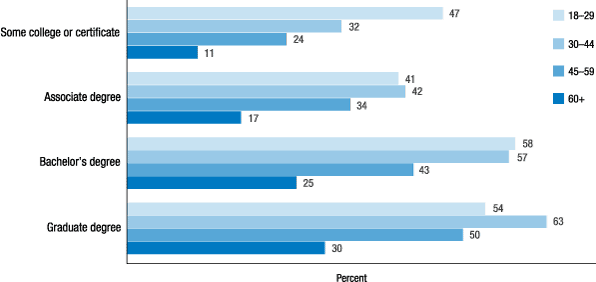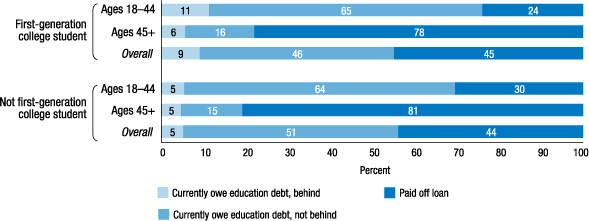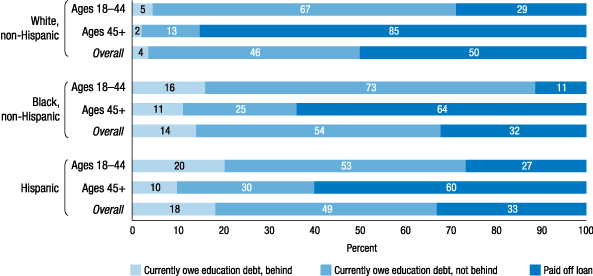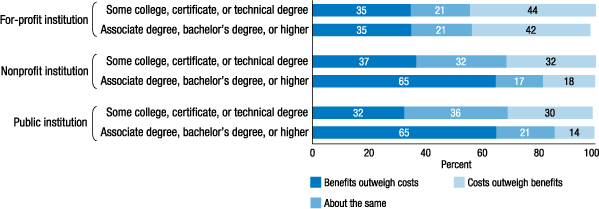Report on the Economic Well-Being of U.S. Households in 2014
- Preface
- Executive Summary
- Introduction
- Overall Economic Well-Being
- Housing and Household Living Arrangements
- Economic Fragility and Emergency Savings
- Savings and Spending
- Banking, Credit Access, and Credit Usage
- Education and Student Loans
- Retirement
Education and Student Loans
Whether an individual attends college and completes his or her degree has long been understood to be a major determinant of lifetime income and financial well-being. However, as real college costs and the percentage of students borrowing to pay for education both continue to rise, the relationship between higher education and lifetime returns may become more complicated. The survey asks respondents about their educational experience, the status of student loans acquired for their education, their perceptions of the value of their degree, and--among those who did not complete a college degree--why they did not continue their education.
The survey results show that the perceived value of borrowing to fund postsecondary education varies widely depending on program completion, type, and major. In particular, while respondents who complete a degree from traditional public or nonprofit institutions overwhelmingly report that their education was worth the cost, perceptions of the value of one's degree are less positive among non-completers and respondents who graduated from a for-profit school. This is consistent with observations from the survey's section on student loan performance, as respondents who fail to complete a degree are also disproportionately likely to fall behind on their student loan payments.
Student Loans Overview
According to the survey, 27 percent of respondents borrowed money to pay for expenses related to their own education, including 15 percent who currently owe money on these loans and 11 percent who borrowed money that they have since repaid. Among just those who completed at least some education beyond high school, 39 percent acquired at least some debt to finance that education, and among those who completed at least a bachelor's degree, 49 percent acquired at least some debt in the process. Reflecting the increased use of student loans among more recent cohorts of college attendees, respondents under age 45 are more likely to have taken out loans for their education for each level of education obtained (figure 16).
Figure 16. Use of student loans to finance own education, including loans which have been fully repaid (by age and highest degree completed)

Note: Among respondents who completed at least some college.
Return to textEducation debt also extends beyond the individual obtaining the education. In addition to the 15 percent of individuals who currently owe money on loans for their own education, 6 percent report owing money for a spouse's education and 6 percent hold debt acquired for a child's or grandchild's education. Recognizing that some individuals owe money for multiple persons' educations, overall 23 percent of individuals say that they currently owe money on education loans for themselves or someone else.
While much of this education debt is in the form of student loans, this is only part of the story. The survey results illustrate that lending products besides student loans are also used to finance higher education. Among all respondents who currently owe money for their own education or that of a family member, 14 percent have credit card debt from educational expenses, 5 percent used a home equity loan, and 11 percent have some other debt besides student loans that was used to pay for education (table 13).10 The use of lending products other than student loans varies somewhat based on whose education the debt is for. In particular, credit card usage is somewhat more prevalent among those borrowing to pay for their own education, while home equity loans are used more frequently among those borrowing to pay for a child's or grandchild's education.
The average combined balance of student loan debt for those who report owing at least some money is $35,657 and the median balance is $18,000. When considering only student loans for one's own education, the average current balance is $30,182 and the median is $16,000.11
Among those who indicate that they are currently making payments on loans for their own education, the average monthly payment is $681, with a median value of $200. A sizeable fraction--39 percent--of respondents with outstanding student loan debt indicate that their loan is in deferment. Fourteen percent are behind or in collections on their student loan.
| Student loan |
Home equity loan |
Credit card |
Other loan |
Respon- dents |
|
|---|---|---|---|---|---|
| Your own education | 92.4 | 3.7 | 16.3 | 10.6 | 833 |
| Spouse's/partner's education | 91.6 | 2.7 | 12.4 | 7.5 | 296 |
| Child's or grandchild's education | 74.0 | 7.5 | 10.2 | 11.9 | 352 |
| Overall | 89.0 | 4.9 | 14.4 | 10.6 | 1,272 |
Note: Among respondents who owe any education debt for each education category.
Student Loan Payment Status by Demographic and Education Characteristics
Among all respondents who have ever had student loan debt for their own education, 8 percent report that they are currently behind on their payments, just under half have outstanding debt and are current on their payments, and 44 percent have completely paid off their loan.12 However, the risk of falling behind on payments is not uniform across the population, either because borrowers acquire education with differing levels of expected returns or because the actual return on education for some borrowers is not congruent with the size of the loan. Therefore, it is valuable to explore the characteristics of borrowers who are most at risk of being unable to manage their student loan payments.
One factor that is clearly associated with delinquency is failure to complete the degree for which the debt was incurred. Sixteen percent of borrowers who did not complete any degree or certificate report being behind on their payments 13 and 17 percent of those who completed a certificate or technical degree are behind. This compares to just 6 percent of those who completed an associate degree, 4 percent of bachelor's degree recipients, and 3 percent of graduate degree recipients who are behind on their payments.
The survey asks respondents about the highest level of education that their parents completed, which partially reflects their parents' income and economic resources. According to the survey, individuals whose parents did not complete a college degree are less likely to have attended college themselves. Respondents in this group who did attend college are also less likely than others to have completed a degree. While two-thirds of college-attendees with a parent who completed a bachelor's degree report that they completed a bachelor's degree themselves, only 38 percent of first-generation college students do so.14
Consistent with their lower completion rates, first-generation college students who took out a student loan for their education are disproportionately likely to report being behind on their payments. Among respondents under age 45, first-generation college students who borrowed are more than twice as likely to be behind on their payments as borrowers with
a parent who completed a bachelor's degree (figure 17). This suggests that these individuals from lower socioeconomic backgrounds are disproportionately likely to be burdened by their student loan payments, either because they are less likely to have completed a degree, because the returns on the degree obtained are less valuable, or because they lack a financial safety net to help them manage the payments if the degree does not pay off.
Figure 17. Payment status of student loans acquired for own education (by age and parental education)

Note: Among respondents who borrowed to pay for their own education.
Return to textSimilar differences also emerge by the race and ethnicity of respondents. Nearly half of white respondents in the survey who attended college completed at least a bachelor's degree, whereas only 40 percent of black respondents and 30 percent of Hispanic respondents did so. Black and Hispanic borrowers are also much more likely than white borrowers to be behind on their loan, and are less likely to have completely repaid their loan (figure 18). The divergence of student loan repayment rates by race/ethnicity suggests that the burden of unmanageable student loan debt may be of greater concern among minority students than it is for white students. This too may be the result of either differences across races and ethnicities in respondents' socioeconomic or educational backgrounds, in their postsecondary educational experiences, or in the wages received for a given credential that then influence their ability to repay student loans.

Note: Among respondents who borrowed to pay for their own education.
Return to textIn addition to differences in loan repayment rates by the level of education and socioeconomic backgrounds of borrowers, one may expect that the type of institution attended could impact the ability to repay student loans. These differences can be explored since the survey asks respondents the name of the institution attended for their undergraduate education or, in the case of students who did not complete at least an associate degree, their most recent educational program. Institutions can then be separated into for-profit, nonprofit, and public schools using the Carnegie Classification of Institutions of Higher Education ™.15
The survey observes that borrowers who attended for-profit institutions are more likely to report being behind on student loans payments than those who attended public or nonprofit schools (table 14). While 6 percent of students who attended a public institution are behind on their student loan payments, 16 percent of those who attended a for-profit institution report that they are behind.
| Currently owe education debt, behind | Currently owe education debt, not behind | Paid off loan |
|
|---|---|---|---|
| Public | 5.8 | 50.6 | 43.7 |
| Private nonprofit | 3.3 | 44.6 | 52.1 |
| Private for-profit | 16.4 | 60.3 | 23.4 |
| Overall | 7.9 | 48.0 | 44.1 |
| Total number of respondents | 1,461 |
Note: Among respondents who took out student loans for their own education.
This high default rate for students who attended for-profit institutions may be partially attributable to differences in the rate of return across education sectors.16 However, just as degree completion is closely related to the socioeconomic and demographic backgrounds of students, students attending for-profit institutions are disproportionately likely to be first-generation college students or minority students and are less likely to complete their degree. Over 95 percent of respondents who attended for-profit institutions went to either part-time/two-year institutions or to institutions classified by the Carnegie Classification™ as having inclusive admissions criteria. In contrast, over half of students attending nonprofit or public institutions went to schools with selective or more selective admissions.17
One way to assess whether the differences in payment status between for-profit, nonprofit, and public institutions is simply due to difference in their selectivity is by comparing the student loan payment status of respondents who attended for-profit schools to those who attended two-year or inclusive public or nonprofit institutions, and excluding those who attended selective public or nonprofit schools. These two-year and inclusive institutions have admissions profiles closer to those of many for-profit institutions. When doing so, the gap between public, nonprofit, and for-profit institutions shrinks but does not disappear completely. Nine percent of students who borrowed to attend a two-year or inclusive public or nonprofit institution report that they are behind on their student loans. While this is a higher rate of being behind on loans than that seen for all students attending public or nonprofit institutions, it remains below the 16 percent of students who borrowed to attend a for-profit institution that are behind.
Student loan repayment status is likely related to a number of factors, including the returns to education, the economic resources of the borrower, as well as the educational preparation of students prior to enrolling in college. The high rate of being behind on loans among individuals who attended for-profit institutions, who are first-generation college students, or who fail to complete their degree suggests that some combination of these explanations impacts the likelihood of default. However, the close link between these educational characteristics and demographic characteristics also means that further research is necessary to fully separate the various potential explanations.
Value of Higher Education by Educational Characteristics
To obtain further information about the perceived returns to higher education, the survey also asks all respondents who attended at least some college, including those who did not borrow for their education, whether they feel that the lifetime financial benefits of their education outweigh the lifetime financial costs. As was the case for the payment status on student loans, responses to this question vary substantially based on demographics of the respondent and the characteristics of their education.
The more education that respondents completed, the more likely they are to indicate that the benefits of their undergraduate education exceed the costs. Among individuals with some education beyond high school but who did not complete at least an associate degree, just 33 percent say that the financial benefits of that education exceed the costs, while 30 percent say that the costs outweighed the benefits. However, 43 percent of those completing an associate degree, 61 percent of those completing a bachelor's degree, and 80 percent of those completing a graduate degree indicate that the financial benefits of their undergraduate education exceed the costs. (Just over 75 percent of respondents who have a graduate degree also say that the lifetime financial benefits of their graduate degree exceed the costs.)
The impact of completing a degree on the perceived value of the education differs substantially based on the type of institution attended. Among respondents who attended a for-profit institution, whether the individual completed their degree has almost no impact on whether they feel that the education was a good investment (figure 19).
Figure 19. Overall, how would you say the lifetime financial benefits of your bachelor's or associate degree program or your most recent educational program compare to its financial costs? (by sector of institution attended and degree obtained)

Note: Among respondents who completed at least some college.
Return to textContrast this with the self-perceived value of education for those who attended public or nonprofit institutions. Among respondents who failed to complete at least an associate degree from these types of schools, about one-third say that the benefits outweigh the costs--which is in-line with that seen at for-profit institutions. However, graduates of nonprofit and public institutions are much more likely to say that their education was worth the investment, which is not the case among graduates of for-profit institutions. Additionally, this result is not purely due to the selectivity of the institutions, as 52 percent of respondents who graduated from part-time or inclusive public or nonprofit institutions also feel that the benefits outweigh the costs of attendance, compared to 15 percent who feel that the costs were greater.
There is also some evidence from the survey results that the field of study impacts how respondents with similar levels of education value their degree (table 15). Looking just at respondents who completed at least an associate degree, those with degrees in engineering or life sciences are the most likely to report that the benefits of their degree exceed the costs. In contrast, respondents with at least an associate degree who majored in a vocational/technical field, humanities, or social/behavioral sciences are the least likely to report that the benefits exceed the costs.
| Benefits outweigh costs | About the same | Costs outweigh benefits | |
|---|---|---|---|
| Engineering | 79.5 | 12.7 | 7.7 |
| Life sciences | 74.4 | 14.9 | 10.7 |
| Physical sciences/math | 69.9 | 18.9 | 10.9 |
| Health | 67.4 | 14.0 | 18.5 |
| Education | 67.3 | 10.7 | 21.0 |
| Business/management | 65.2 | 20.7 | 13.5 |
| Computer/information sciences | 64.3 | 24.2 | 11.6 |
| Law | 63.1 | 19.9 | 17.1 |
| Social/behavioral sciences | 51.1 | 25.3 | 23.7 |
| Humanities | 50.8 | 28.4 | 20.8 |
| Vocational/technical training | 45.8 | 35.9 | 17.0 |
| Undeclared | 36.1 | 37.5 | 22.0 |
| Other | 49.5 | 22.6 | 27.9 |
| Refused to state | 20.5 | 29.0 | 15.0 |
| Overall | 62.7 | 20.3 | 16.5 |
| Total number of respondents | 2,279 |
Note: Among respondents who completed at least an associate degree.
Reasons for Not Starting or Not Finishing College
Recognizing that 37 percent of respondents have no education beyond high school and another 19 percent completed some college but have no certificate or degree from that education, the survey asks respondents who did not attend or did not complete college what influenced that decision. Respondents could select all responses that applied to their situation.
Among all respondents who did not attend college, the most common reasons provided for why they did not attend are that they simply were not interested (38 percent), because they felt it was too expensive (31 percent), because they wanted to work (30 percent), or because of family responsibilities (26 percent) (table 16). The reasons cited for not attending college differ, however, by the race and ethnicity of respondents. A lack of interest is cited most frequently by white respondents (43 percent), but is only the third-most common response among black and Hispanic respondents (28 percent each). Hispanic respondents, instead, most frequently cite family responsibilities (43 percent) as the reason for not attending college, while black respondents most frequently indicate that they wanted to work (37 percent) or had family responsibilities (29 percent) which prevented them from continuing their education.
| Reason for not attending college |
Reason for not completing degree |
|
|---|---|---|
| Too expensive | 30.7 | 24.4 |
| Family responsibilities | 25.8 | 37.6 |
| Wanted to work | 30.4 | 27.0 |
| Simply was not interested in college/continuing in college | 38.1 | 25.3 |
| Was not admitted/low grades | 1.1 | 7.4 |
| Benefits of attending/continuing college were not worth the cost | 12.3 | 16.7 |
| Other | 10.9 | 17.9 |
| Total number of respondents | 1,828 | 866 |
Note: Among respondents who did not attend college or did not complete degree. Excludes respondents who indicated they did not complete degree because they are still enrolled.
Turning to students who attended college but did not finish and are no longer enrolled, 38 percent say that they dropped out due to family responsibilities. This exceeds the fraction seen for any other reason by at least 11 percentage points. The most common responses to this question are consistent across racial and ethnic groups, with blacks, whites, and Hispanics all citing family responsibilities most frequently as a reason for not completing their education. However, Hispanics are more likely than whites or blacks to say that they left school because it was too expensive, while whites are more likely than blacks or Hispanics to say that they left school because they were simply not interested or because they did not think the benefits were worth the cost.
The reasons why respondents did not complete their college degree also differ notably by gender. Forty-three percent of women who started college, but left without completing their degree, state that family responsibilities were a reason that they did not continue their education. This is substantially greater than the 32 percent of men who say that family responsibilities prevented them from completing their degree. The gender gap in citing family responsibilities is at least as large among younger respondents. Among respondents under age 45 who did not complete their degree, 49 percent of women and 28 percent of men say that family responsibilities played a role.
References
10. Educational expenses are not necessarily limited to tuition, so this use of credit cards and other lending products may include purchasing textbooks as well as other purchases associated with the education. Return to text
11. Both the mean and median are higher than those observed in other student loan data, including the 2013 SHED. Although the 2014 survey asks respondents specifically about their student loan balance, immediately prior to this question respondents are asked about the form of their education debt, including credit card debt and home equity loans used for educational purposes. This may have primed respondents to think about their education debt more broadly when reporting the balance, possibly leading to the higher estimates. Return to text
12. These results, as well as subsequent results in this section regarding student loan payment status, exclude the small number of individuals who report that they currently owe money for their education debt but that the debt is not in the form of a student loan. These individuals, who make up approximately 4 percent of all respondents who borrowed for their education, were not asked about the payment status of that debt. Return to text
13. Among respondents who did not complete any degree and report that they are no longer enrolled in the program for which they borrowed, an even higher 21 percent indicate that they are behind on their payments. Return to text
14. First-generation college students are considered individuals who do not report that at least one parent completed a bachelor's degree. Return to text
15. For more details on the Carnegie Classification, see http://carnegieclassifications.iu.edu/ ![]() . Return to text
. Return to text
16. See David J. Deming, Claudia Goldin, and Lawrence F. Katz (2012), "The For-Profit Postsecondary School Sector: Nimble Critters or Agile Predators?" Journal of Economic Perspectives, vol. 26 (1), pp. 139-64, for a discussion of the rates of return by education sector. Return to text
17. The Carnegie Classification™ defines selective institutions as those whose first-year students' test scores place most of these institutions in roughly the middle two-fifths of baccalaureate institutions and more selective institutions as those whose first-year students' test scores place these institutions in roughly the top fifth of baccalaureate institutions. Inclusive institutions extend educational opportunities to a wide range of students with respect to their academic preparation (see http://carnegieclassifications.iu.edu/descriptions/undergraduate_profile.php ![]() for further information on the selectivity classifications). Return to text
for further information on the selectivity classifications). Return to text
